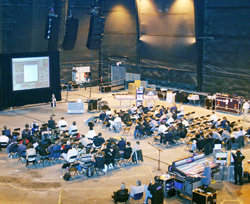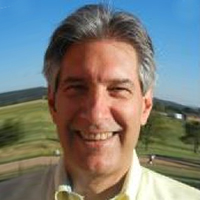A few years ago, I was asked to make a presentation about equalizing line arrays at a concert sound seminar.
My specific assignment: discuss the equalization of line arrays in concert settings, in combination with Robert Scovill detailing his approach towards the same. Since we’d never formally met, and Robert’s background is from an “in the trenches” viewpoint while mine is largely from the “ivory tower” of a “factory marketing geek,”
I was a little apprehensive that we might have clashing techniques. This proved to be anything but the case.
Robert’s presentation was very informative. His first request to touring companies when he’s mixing on a line array system is to “please load the factory specified presets into the digital loudspeaker processor.”
This was music to my ears – I’ve been preaching that “rolling your own” settings is an almost impossible task with line arrays. Even with a measurement system, a line array’s response is different at every distance. And changing crossover frequency and delay settings away from factory presets can also cause unexpected polar-response changes that can come back to bite later, and it’s difficult to even know the cause of the problem.
Based upon his experiences, Robert is aware of these pitfalls and thus always starts with the factory presets, knowing that manufacturers have spent countless hours optimizing the basic settings for the best overall results. Given this solid starting point, equalization modifications to account for room coupling at low frequencies, as well as the number of boxes and the splay between each, can both be determined. How, then, is this to be done? (More later…)
My presentation kicked off with an explanation of how long an array needs to be to act as a true line array at a particular frequency, and that many so-called “line arrays” are simply vertically oriented loudspeaker clusters that sound nice because the factory preset is well done.
Next, I demonstrated how a particular frequency will generally follow the -3 dB per doubling with distance slope within critical distance from the array, but will oscillate at a unique period. This means that at a given distance from the array, adjacent frequencies may be up or down several dB relative to each other, and that this can be the opposite at a different distance.
Therefore, line array equalization MUST be done using an average response, comprised of several measurements made at difference distances from the array.
With this in mind, what was Mr. Scovill’s approach to equalizing line arrays? The same, accomplished by averaging several Smaart measurements at different distances from the array. (This warmed the cockles of my factory-geek heart!) He even insisted on PZM’ing (pressure zone miking) the microphone on the floor for each sample measurement, something I’ve been recommending for quite some time.
One of Robert’s key points is that the closest measurement should be about one-third of the way into the seating/coverage area, not using the array’s response in the first several rows of seating.















